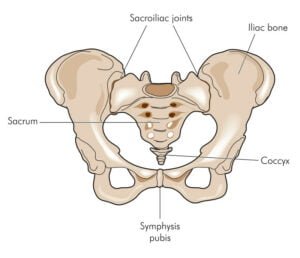SI joint pain, or sacroiliac joint pain, is a common discomfort that affects the lower back and hips. This condition can be quite debilitating, limiting one’s mobility and overall quality of life. In this article, we’ll delve into the various aspects of SI joint pain and how physical therapy can provide effective relief.
Contents
Causes of SI Joint Pain

SI joint pain, or sacroiliac joint pain, refers to discomfort or pain in the sacroiliac joints. These are located at the base of the spine where the sacrum (the triangular bone at the lower back) connects with the ilium bones of the pelvis. Several factors can contribute to SI joint pain:
- Inflammation: Inflammation of the SI joint, often known as sacroiliitis, can result from conditions like ankylosing spondylitis, psoriatic arthritis, or other inflammatory disorders. This inflammation can cause pain, stiffness, and discomfort.
- Joint Dysfunction: Dysfunction in the SI joint can occur due to irregular movement, excessive movement (hypermobility), or insufficient movement (hypomobility). This can cause pain and discomfort in the lower back, buttocks, and legs.
- Trauma: Any significant trauma, such as a fall, car accident, or sports injury, can damage the SI joint or the ligaments around it. This leads to pain and discomfort.
- Pregnancy: During pregnancy, hormonal changes can lead to increased joint laxity, including the SI joints. This can cause pain and discomfort, particularly in the later stages of pregnancy.
- Degenerative Joint Disease: Over time, wear and tear on the SI joint can lead to degeneration of the joint surfaces, resulting in pain and stiffness. This is more common in older adults.
Diagnosing SI Joint Pain
Diagnosing SI joint pain involves a combination of medical history assessment, physical examination, and possibly imaging studies. Here’s how the process typically works:
- Medical History: Your healthcare provider will start by discussing your symptoms, including the location, type, and duration of your pain. They will also ask about any previous injuries, medical conditions, or activities that might be contributing to your pain.
- Physical Examination: A physical examination is crucial for assessing the SI joint and its surrounding structures. During the exam, the healthcare provider may perform various maneuvers to evaluate the range of motion, pain triggers, and any signs of joint dysfunction.
- Provocative Tests: There are specific tests designed to provoke pain in the SI joint and help diagnose its involvement. For example, the Patrick’s (FABER) test involves moving your leg into different positions to stress the SI joint and assess for pain or discomfort.
- Imaging Studies: While imaging is not always necessary, it can provide valuable information about the SI joint and rule out other potential causes of pain. Common imaging techniques include:
- X-rays: These can show signs of degeneration, arthritis, or structural abnormalities in the SI joint.
- MRI (Magnetic Resonance Imaging): MRI can provide detailed images of the soft tissues, including the ligaments, cartilage, and surrounding structures.
- CT (Computed Tomography): CT scans can offer cross-sectional images of the SI joint and help visualize bony structures in greater detail.
Benefits of Physical Therapy

Physical therapy offers a wide range of benefits for individuals with various medical conditions, injuries, or physical limitations. Here are some of the key benefits of physical therapy:
- Pain Relief: Physical therapists use various techniques, exercises, and modalities to alleviate pain. They can target specific areas of discomfort and help manage chronic pain conditions.
- Improved Mobility and Function: Physical therapy aims to restore and enhance your ability to move, whether you’re recovering from an injury, surgery, or dealing with a chronic condition. Therapists work on improving flexibility, strength, and joint range of motion.
- Injury Prevention: Physical therapists assess movement patterns and identify areas of weakness or imbalance that might make you prone to injuries. They develop personalized exercise programs to address these issues and reduce the risk of future injuries.
- Recovery from Surgery: For individuals who have undergone surgery, physical therapy can aid in the recovery process. Therapists help restore strength, flexibility, and function to the affected area while ensuring safe healing.
- Enhanced Balance and Coordination: Physical therapy exercises often focus on balance and coordination training. It is especially for older adults who are at risk of falls. This can significantly improve quality of life and reduce the risk of injuries due to falls.
Physical Therapy Techniques for SI Joint Pain
Physical therapy can be highly effective in managing and alleviating SI joint pain. A skilled physical therapist will create a personalized treatment plan based on your individual needs, but here are some common techniques and approaches they might use for SI joint pain:
- Manual Therapy: Skilled hands-on techniques are used to mobilize and manipulate the SI joint and surrounding structures. This can help improve joint mobility, reduce muscle tension, and alleviate pain.
- Strengthening Exercises: Strengthening the muscles around the SI joint, including the core, hips, and lower back, can provide better support and stability to the joint. Exercises might include bridges, clamshells, and various core strengthening exercises.
- Stretching: Gentle stretching of the muscles around the SI joint can help improve flexibility and reduce tension. Hamstring, hip flexor, and piriformis stretches are commonly used.
- Postural Training: Correcting posture imbalances can relieve stress on the SI joint. Your physical therapist will help you become more aware of your posture and provide exercises to improve it.
- Pelvic Stabilization Exercises: These exercises focus on stabilizing the pelvis and strengthening the muscles that support the SI joint. They can include pelvic tilts, leg lifts, and stability ball exercises.
- Modalities: Physical therapists might use modalities like heat, ice, ultrasound, or electrical stimulation to alleviate pain and reduce inflammation in the SI joint area.
- Biofeedback: This technique helps you learn to control and strengthen specific muscles through visual or auditory feedback. It’s often used to enhance awareness and control of the pelvic muscles.
- Gait and Movement Analysis: If your gait (walking pattern) is contributing to your SI joint pain, a physical therapist can analyze your movement and provide corrective strategies.
- Patient Education: Understanding the causes of SI joint pain and learning how to avoid aggravating activities or movements is essential. Your therapist will educate you about proper body mechanics and posture.
- Functional Training: As you progress, your therapist will incorporate functional exercises that mimic daily activities. This is to ensure that your improved mobility and strength translate into real-life scenarios.
When to Consult a Professional?

If you’re experiencing SI joint pain or any persistent musculoskeletal discomfort, it’s important to know when to consult a healthcare professional. Here are some signs that indicate it’s time to seek medical help:
- Persistent Pain: If you’re experiencing ongoing pain in the lower back, buttocks, hips, or groin that doesn’t improve after a few days of rest or self-care.
- Limited Range of Motion: If you notice a decrease in your ability to move your hips, pelvis, or lower back comfortably, or if you feel stiff and restricted in these areas.
- Pain During Activities: If your pain is exacerbated by specific activities or movements, such as bending, lifting, walking, or standing, and it’s affecting your ability to perform daily tasks. Then it’s time to consult a healthcare provider.
- Pain at Night: Pain that consistently disrupts your sleep or wakes you up at night. This could indicate a more serious issue that should be evaluated by a professional.
- History of Trauma: If you’ve experienced a fall, accident, or other trauma that might have affected your lower back, pelvis, or hips, and you’re now experiencing pain in those areas, seeking medical attention is important.
- Progressive Symptoms: If your pain is worsening over time or you’re noticing additional symptoms such as numbness, tingling, weakness, or radiating pain into the legs. It’s a sign to consult a professional promptly.
Conclusion
Physical therapy presents a promising avenue for effectively managing SI joint pain. Through personalized treatment plans, lifestyle adjustments, and a collaborative approach, individuals can find relief and regain their mobility.
Remember that early intervention and proper guidance from healthcare professionals are essential for effectively managing SI joint pain. With the right treatment approach and commitment to your therapy, you can work towards reducing pain, improving mobility, and regaining control over your physical well-being.
Physical Therapy helps patients recover from pain. If you’re experiencing Back, Shoulder, Knee, Neck, Elbow, Hip, or Arthritis pain, a physical therapist at PhysioMantra can help: Book an online physical therapy session.



